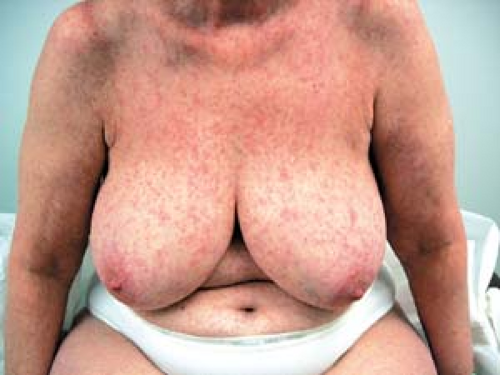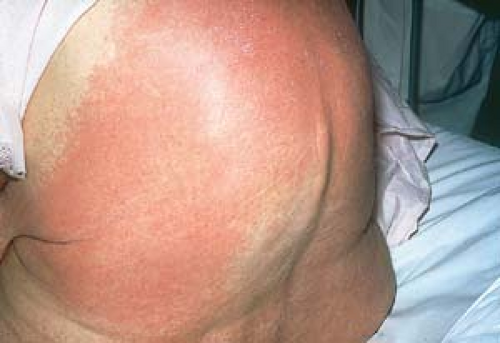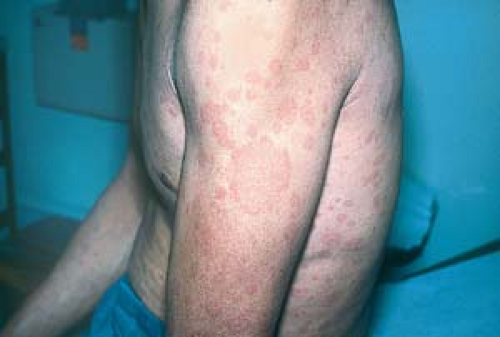Drug Eruptions
 Exanthematous drug eruption
Exanthematous drug eruption
 Urticarial drug eruption
Urticarial drug eruption
 Drug photosensitive or phototoxic eruption
Drug photosensitive or phototoxic eruption
 Fixed drug eruption
Fixed drug eruption
 Erythroderma
Erythroderma
 Hypersensitivity syndrome
Hypersensitivity syndrome
 Leukocytoclastic vasculitis
Leukocytoclastic vasculitis
 Erythema multiforme major
Erythema multiforme major
 Toxic epidermal necrolysis
Toxic epidermal necrolysis
 Lichenoid drug eruption
Lichenoid drug eruption
 Lupus-like drug eruption
Lupus-like drug eruption
 Acneiform drug eruption
Acneiform drug eruption
Overview
An adverse drug reaction is any nontherapeutic deleterious effect of a prescribed or over-the-counter medication. Drug eruptions can mimic almost any dermatosis. Drug reactions may be allergic (immunologic) or nonallergic (toxic). Allergic-type drug reactions are not dose dependent. They are classified as the four following types of immunologic reactions:
Type I: classic immediate hypersensitivity (urticaria, angioedema, anaphylaxis)
Type II: cytotoxic (hemolysis, purpura)
Type III: immune complex (vasculitis, serum sickness, urticaria, angioedema)
Type IV: delayed hypersensitivity (contact dermatitis, exanthematous reactions, photoallergic reactions)
Nonallergic drug eruptions are more common than allergic-type eruptions; they may be dose related or idiosyncratic. Vertigo caused by high-dose minocycline, demethylchlortetracycline-related photosensitivity reactions, and irritant reactions from topical retinoids are examples.
Basics
Most drug eruptions are exanthematous (red rashes) and usually fade in a few days.
More serious reactions include erythema multiforme major (Stevens-Johnson syndrome), toxic epidermal necrolysis, and serum sickness.
The presence of urticaria, mucosal involvement, extensive or palpable purpura, or blisters almost always requires discontinuation of the responsible drug. Certain classes of systemic medications, such as antimicrobial agents, nonsteroidal anti-inflammatory drugs (NSAIDs), cytokines, chemotherapeutic agents, and psychotropic agents, are associated with a high rate of cutaneous reactions. Risk factors include the following:
Age: Drug eruptions are more commonly seen in elderly persons because they often take more drugs than younger people and they often take more than one drug at a time; consequently, they are more likely to have been previously sensitized.
A history of previous drug reactions is a risk factor.
A family history of drug eruptions is another factor.
Prolonged use of a drug can predispose patients to drug eruptions.
Paradoxically, although human immunodeficiency virus (HIV) infection causes profound anergy to other immune stimuli, the frequency of drug hypersensitivity reactions is increased markedly compared with both immunocompetent and HIV-negative immunocompromised populations.
Characteristic Skin Reactions Produced by Drugs
Adverse cutaneous drug reactions can mimic many common non-drug-related skin eruptions, and certain drugs are more likely to cause characteristic reactions in the skin, as follows:
Exanthems and urticarial reactions: sulfonamides, penicillins, hydantoins, allopurinol, quinidine, angiotensin-converting enzyme inhibitors, barbiturates, carbamazepine, isoniazid, NSAIDs, and phenothiazine, as well as thiazide diuretics, aspirin, blood products, cephalosporins, dextran, opiates, radiocontrast dye, ranitidine, and vaccines
Acneiform eruptions: systemic steroids, topical steroids, lithium, oral contraceptives, and androgenic hormones
Photo-induced: tetracyclines, particularly demethylchlortetracycline and doxycycline; griseofulvin; certain diuretics; sulfonylurea agents used to treat diabetes; NSAIDs; and phenothiazines
Erythema nodosum: iodides, oral contraceptives, penicillin, gold, amiodarone, sulfonamides, and opiates
Bullous eruptions: penicillin, sulfonamides, captopril, iodides, gold, and furosemide
Purpura: anticoagulants and thiazides
Vasculitic eruptions: allopurinol, aspirin or other NSAIDs, cimetidine, gold, hydralazine, penicillin, phenytoin, propyl-thiouracil, quinolones, sulfonamide, tetracycline, and thiazides
Erythema multiforme major (Stevens-Johnson syndrome) and erythema multiforme minor: sulfonamides, penicillins, tetracyclines, hydantoins, and barbiturates
Fixed drug eruptions: tetracyclines, sulfonamides, griseofulvin, barbiturates, phenolphthalein, and NSAIDs
Contact dermatitis: neomycin and preservatives in topical medications
Description of Lesions
The morphology of a drug eruption can often provide clues to the most likely responsible agent.
Exanthematous Drug Eruption
Urticarial Drug Eruption
Urticarial drug eruptions usually occur as wheals that may coalesce or take cyclic or gyrate forms (Fig. 17.3).
Lesions usually appear shortly after the start of drug therapy and resolve rapidly when the drug is withdrawn (see also Chapter 18, “Diseases of Vasculature”).
Stay updated, free articles. Join our Telegram channel

Full access? Get Clinical Tree








